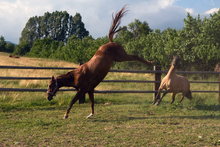With equine osteoarthritis (OA) having a major impact on the horse industry and sometimes determining the level of performance for many riders and their equine companions, understanding and being able to treat the pain and inflammation associated with equine OA is critical for the long-term health care of horses, especially those involved in competition.
Now horse owners can turn to a new website launched by Merial, to learn more about OA, what causes it, the clinical signs and how to treat the pain and inflammation associated with this often debilitating condition.

Merial - Helping horses kick up their heels
The term OA (sometimes called degenerative joint disease or DJD) refers to a group of disorders, identified by progressive deterioration of the articular cartilage in the horse's limbs.
The term OA (sometimes called degenerative joint disease or DJD) refers to a group of disorders, identified by progressive deterioration of the articular cartilage, (cartilage that covers the end surfaces of bones connected at a joint). Coupled with this progressive deterioration are changes in the bone and soft tissues of the joint. Once damaged, articular cartilage can never be restored to its original state.
Clinical signs of OA include limping or lameness, decreased activity or exercise and stiffness or decreased movement of joints. A veterinarian can use a variety of tools to diagnose OA, including nerve and joint blocks, radiographs, ultrasound, thermography, fluoroscopy, nuclear scintigraphy, computed tomography scan (CT) and magnetic resonance imaging (MRI).
While OA can’t be cured, the inflammation and subsequent pain associated with it can be treated. “There are multiple approaches to treating horses with OA that have the potential to make them more comfortable and regain function,” says Hoyt Cheramie, DVM, MS, equine specialist for Merial’s Large Animal Services. “Horse owners should work with their veterinarians to determine which course of action is going to be the most effective in their particular situation. And then, the horse owner should follow the veterinarian’s instructions very carefully in order to achieve the best result.”
One option for treating horses with joint inflammation associated with equine osteoarthritis is EQUIOXX® (firocoxib), which is effective for 24 hours* with just one daily dose. There are two formulations available, injection and paste. Between the two, EQUIOXX is approved for use for a total of up to 14 consecutive days; of which EQUIOXX injectable should not be used for more than five days.3 EQUIOXX is approved for use in competition by the United States Equestrian Federation and American Quarter Horse Association for a total of up to 14 consecutive days.
“Whenever horse owners are using NSAIDs, it’s important for them to consult with their veterinarians to determine the best course of action, including medications and exercise, for the horse’s overall health,” says Dr. Cheramie.
*Joint pain and inflammation associated with equine osteoarthritis, also called degenerative joint disease.
IMPORTANT SAFETY INFORMATION: As with any prescription medication, prior to use, a veterinarian should perform a physical examination and review the horse’s medical history. A veterinarian should advise horse owners to observe for signs of potential drug toxicity.
As a class, nonsteroidal anti-inflammatory drugs may be associated with gastrointestinal, hepatic and renal toxicity. Use with other NSAIDs, corticosteroids or nephrotoxic medication should be avoided. EQUIOXX has not been tested in horses less than 1 year of age or in breeding horses, or pregnant or lactating mares.
